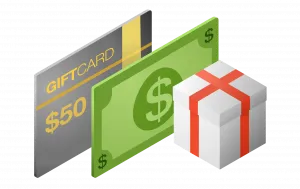How to Tell if Your Loyalty Program is Working
While a dedicated software platform can automate most of the work, loyalty programs aren’t something you set and forget - they’re an always-evolving part of your marketing mix.
Adopting a continuous improvement mindset means you’ll attract more customers, increase the value of ones you already have, and ensure you’re getting the best return on your investment.
Consumer preferences shift, seasonal factors influence shopping habits, and your company’s access to resources fluctuates, meaning that your loyalty strategy will undergo iterations to adjust for the best results.
One of the biggest advantages of running a digital loyalty program is having access to detailed analytics.
With the right knowledge, the numbers reveal more than you might think. Understanding the relationship between each metric helps you determine how engaging, compelling, and financially sustainable your program really is.
Here are four important metrics you should track to gain insight into how your loyalty program is performing, plus strategies to improve each one.
- Is your loyalty program engaging?
- Is your loyalty program making you money?
- Is your program perceived as valuable by your members?
- Is your loyalty program compelling?
Is your loyalty program engaging?
Participation Rate = Active Members / Total Number of Customers
- Active loyalty program members: The number of customers who have directly engaged with some aspect of your loyalty program (ie. signed up, earned a reward, etc).
- Total customers: The total number of customers you have.
What you can learn from your participation rate
Weighing your loyalty program members against your total customers helps you learn whether your programs are gaining traction and popularity, or if people are losing interest.
Participation rates are largely dependent on whether your program is easy to find, simple to join, and attractive to engage with.
A program structure and messaging that is inviting for all types of customers in your target market will draw in the best crowd.
How to make your loyalty program more engaging
Refresh your promotional strategy
If your loyalty program isn’t driving the engagement you hoped for, the problem might be that no one knows it exists.
Believing your loyalty program will promote itself is a common misconception. Even global giant AirBnB cites a lack of promotion as one of their early referral program’s biggest problems – not even their employees knew it existed.
Some great places to promote your loyalty program are on your website, within your application, through an email campaigns, on customer invoice notes, and in email signatures. For more promotional strategies to maximize engagement, check out this article.
Reward users at every point in the life cycle
If you’re only rewarding for one kind of customer action, such as leaving a review or making a referral, new customers may self-disqualify themselves if they feel they’re not far along enough in the lifecycle to participate.
A loyalty strategy is meant to extract value from, and offer rewards to users from the moment they land on your website, to well beyond their 20th purchase. Consider offering incentives for new-user activities like downloading the app, following a tutorial, or completing their profile.
To learn more about rewarding the right kind of customer behavior, check out this post.
For more ways to improve your program participation rate, check out this article.
Is your loyalty program making you money?
Basic return on investment (ROI) = ( Revenue generated - Rewards Earned ) / Rewards earned
- Revenue generated: The total of all purchases made by any customer that is attributed to your program.
- Rewards earned: The total of all rewards that participants have earned, but not yet redeemed.
What you can learn from your ROI
The ROI of your loyalty program indicates whether you’re making a profit as a result of offering loyalty rewards.
It shows whether the revenue (return) you make from acquiring new customers or purchases with rewards is enough to justify the cost (investment) of the rewards you offer.
As a basic rule, your loyalty program should ensure the lifetime value of a customer (ie. how much money they spend) exceeds the cost needed to acquire them.
If your ROI is greater than 1, then your reward structure is profitable. For most digital services, your target ratio should be around 3.
If your ROI is negative, this means that your reward structure is not financially sustainable, and while you might be acquiring new customers, you’re ultimately losing money by offering rewards that are too expensive, or too easy to obtain. This may be desirable if growth is more important than profit, such as in a land-grab situation where you need to acquire customers before your competitors can.
For a more detailed calculation of the ROI of your acquisition rewards, download a free copy of our ROI Excel calculator.
How to improve your ROI
Remember that high cost doesn’t always equal high value
The best rewards to offer aren’t always the most expensive.
Many digital companies are realizing that it pays to think outside the box when it comes to loyalty program rewards, and play to customers emotions rather than their wallets by rewarding with alternative currencies.
Unlike a $10 store credit or 50% discount, alternative currencies don’t have an obvious cash equivalent but have the potential to deliver extreme value to customers by capitalizing on your company’s existing assets, network, and value proposition.
Some quick examples include free shipping, access to exclusive content, a complimentary training session with a product expert, free swag, or early access to a new feature.
Although these aren’t necessarily free to offer, you can avoid an upfront material investment and possibly repurpose items you already have on hand.
Know how much you can afford to offer
If you don’t take the time to calculate what you can afford to offer as rewards, you may quickly drive sales but eventually hurt your profit.
A loyalty program done right will cover any standard costs involved, but you must make sure your proposed strategy is sustainable given your current financial health.
As an example, Tesla’s first iteration of their referral program ended because the reward structure was cutting too much into the company’s margins.
Even so, they re-evaluated their financial position and customer preferences to unveil a restructured referral program weeks later, with the intention of “[saving] the company money while also offering rewards that are super exclusive.” (source)
Check out our step-by-step guide on how to calculate the ROI of your acquisition rewards and learn how much you can afford to offer.
Is your program perceived as valuable by your members?
Redemption Rate = Rewards redeemed / Rewards earned
- Rewards earned: The total of all rewards that participants have earned.
- Rewards redeemed: The total of all rewards that participants have redeemed.
What you can learn from your redemption rate
Your reward redemption rate indicates how valuable customers perceive your rewards to be.
Ideally, a customer will earn a reward, and redeem it immediately because they’re excited to obtain something of value.
Declining redemption rates may indicate that your rewards need an update, as customers aren’t taking action to follow through with the redemption process. If this is the case, you risk people churning from both your loyalty program and your brand altogether.
Low redemption rates can also be the result of users earning rewards without even knowing it, or not receiving sufficient notifications or reminders that they have anything to redeem.
Make sure you’re running your loyalty programs on a reliable platform to avoid any software-related redemption issues.
How to increase the perceived value of your loyalty program
Remember the wants and needs of your target customers
Are your program’s rewards based on what you know will be valuable to the customer, or based on what is easy or cheap for you to offer? If the latter, customers will quickly start to feel like there’s nothing in it for them.
As a company, if you can’t articulate the value you’re providing to clients, you’re missing the whole point.
Whether you developed a loyalty strategy to help boost sales, increase customer lifetime value, or expand your product reach, being too focused on your own needs will eventually deter customers.
Ask your customers what they want
If nothing comes to mind when you think about what your customers want, it’s time to ask them!
Knowing exactly what motivates your customers to take action is one of your most powerful pieces of information for a successful loyalty strategy.
Use focus groups, online surveys, social media polls, or calling campaigns to ask customers for feedback and take out the guesswork.
For starters, check out the 5 top questions to ask about your customers and your business for choosing the best rewards.
Review your redemption process
It’s possible that your reward redemption process is too complicated or strict. This also ends up hurting your overall participation rate when users can no longer justify their enrolment.
Incentive-based loyalty programs only work when they are clearly mutually-beneficial: Customers can receive rewards for making a purchase, and the company benefits from the added revenue.
As we mentioned in our article about the most costly loyalty program mistakes, some of the worst things you can do are make customers do math to figure out their reward balances, or have them jump through extra hoops to claim an offer.
Send sufficient reward notifications and reminders about reward balances with clear instructions for a simple redemption process.
For 5 more ways to improve your reward redemption rate, check out this article.
Is your loyalty program compelling?
Metric: Goals Completed
This metric represents the total number of times a goal was achieved in your program. For example, a “goal” is completed every time a referred customer is successfully converted through your referral program.
What you can learn from your completed goals
 The number of program goals completed indicates how compelling customers perceive your overall program message to be. It’s affected largely by the language and copy you use to promote your program, and the actions you’re asking customers to complete.
The number of program goals completed indicates how compelling customers perceive your overall program message to be. It’s affected largely by the language and copy you use to promote your program, and the actions you’re asking customers to complete.
An upward-trending number of goals completed means that you’re rewarding the right kind of action (ie. download the app, make a purchase) to move users through each stage of their lifecycle. What you’re asking of the customer (and how you’re asking it) makes sense to them given their maturity, commitment level, and product knowledge.
However, it’s possible for your program to be perceived as valuable, yet still suffer from a low amount of goals completed. Even if your rewards are desirable, users will refrain from participating and completing the desired action if they feel like the rewards are impossible to earn, or the required action doesn’t make sense for their position in the lifecycle.
Alternatively, if your participation rate is high relative to your overall customer base, but your goals completed metric is stagnant, this could indicate that your first offer was enticing, but you haven’t followed up with the customer enough to further participation.
How to make your programs more compelling:
Review the customer actions you are rewarding
What are you asking customers to do in order to receive a reward? Does this line up with where they are in the customer lifecycle? If you’re not strategically selecting what customer behavior to incentivize, you could be asking too much or too little of your customers - both of which are deterring.
As customers mature throughout their journey with your brand, their knowledge, confidence, and commitment levels vary, making it necessary to customize the behavior for which they are rewarded.
As an example, a user who just came across your website is not someone you want to encourage to leave a product review, because they haven’t had the time to form a genuine opinion.
Similarly, you’re better off incentivizing a long-time client to refer a friend than to complete an in-app tutorial, as their loyalty is an extremely valuable tool for referring new business.
Make sure your rewards are attainable
Just like you want to make sure the customer action is do-able, make sure that once a customer does it, they can realistically obtain a reward.
Data from HelloWorld reveals that over half (53%) of surveyed consumers say it takes too long to receive a reward when participating in a loyalty program.
Similarity, as per the 2017 loyalty census by COLLOQUY, the top reason for loyalty program abandonment is that it took too long to earn points - an answer cited by 57% of respondents
Offering smaller (yet instantly redeemable) rewards throughout a customer’s journey is much more of a compelling proposition than telling customers they must spend $100 before receiving a 5% purchase discount.
Final Thoughts
Consumers belong to an average of 13.4 loyalty programs, but are active in only 6.7 of them. (source)
Involvement in your loyalty program starts with enrolment, but needs to be backed by a compelling message and valuable (yet financially sustainable) rewards.
Keeping track of these four core metrics helps you paint a clear picture of your loyalty program’s performance, plus shed light on any problem areas.
To learn more about designing a successful loyalty strategy in the digital economy, sign up for the Digital Loyalty Academy today. Free access for the first 700 students.
 While a dedicated software platform can automate most of the work, loyalty programs aren’t something you set and forget - they’re an always-evolving part of your marketing mix.
While a dedicated software platform can automate most of the work, loyalty programs aren’t something you set and forget - they’re an always-evolving part of your marketing mix.
Adopting a continuous improvement mindset means you’ll attract more customers, increase the value of ones you already have, and ensure you’re getting the best return on your investment.
Consumer preferences shift, seasonal factors influence shopping habits, and your company’s access to resources fluctuates, meaning that your loyalty strategy will undergo iterations to adjust for the best results.
One of the biggest advantages of running a digital loyalty program is having access to detailed analytics.
With the right knowledge, the numbers reveal more than you might think. Understanding the relationship between each metric helps you determine how engaging, compelling, and financially sustainable your program really is.
Here are four important metrics you should track to gain insight into how your loyalty program is performing, plus strategies to improve each one.
- Is your loyalty program engaging?
- Is your loyalty program making you money?
- Is your program perceived as valuable by your members?
- Is your loyalty program compelling?
Is your loyalty program engaging?
Participation Rate = Active Members / Total Number of Customers
- Active loyalty program members: The number of customers who have directly engaged with some aspect of your loyalty program (ie. signed up, earned a reward, etc).
- Total customers: The total number of customers you have.
What you can learn from your participation rate
Weighing your loyalty program members against your total customers helps you learn whether your programs are gaining traction and popularity, or if people are losing interest.
Participation rates are largely dependent on whether your program is easy to find, simple to join, and attractive to engage with.
A program structure and messaging that is inviting for all types of customers in your target market will draw in the best crowd.
How to make your loyalty program more engaging
Refresh your promotional strategy
If your loyalty program isn’t driving the engagement you hoped for, the problem might be that no one knows it exists.
Believing your loyalty program will promote itself is a common misconception. Even global giant AirBnB cites a lack of promotion as one of their early referral program’s biggest problems – not even their employees knew it existed.
Some great places to promote your loyalty program are on your website, within your application, through an email campaigns, on customer invoice notes, and in email signatures. For more promotional strategies to maximize engagement, check out this article.
Reward users at every point in the life cycle
If you’re only rewarding for one kind of customer action, such as leaving a review or making a referral, new customers may self-disqualify themselves if they feel they’re not far along enough in the lifecycle to participate.
A loyalty strategy is meant to extract value from, and offer rewards to users from the moment they land on your website, to well beyond their 20th purchase. Consider offering incentives for new-user activities like downloading the app, following a tutorial, or completing their profile.
To learn more about rewarding the right kind of customer behavior, check out this post.
For more ways to improve your program participation rate, check out this article.
Is your loyalty program making you money?
Basic return on investment (ROI) = ( Revenue generated - Rewards Earned ) / Rewards earned
- Revenue generated: The total of all purchases made by any customer that is attributed to your program.
- Rewards earned: The total of all rewards that participants have earned, but not yet redeemed.
What you can learn from your ROI
The ROI of your loyalty program indicates whether you’re making a profit as a result of offering loyalty rewards.
It shows whether the revenue (return) you make from acquiring new customers or purchases with rewards is enough to justify the cost (investment) of the rewards you offer.
As a basic rule, your loyalty program should ensure the lifetime value of a customer (ie. how much money they spend) exceeds the cost needed to acquire them.
If your ROI is greater than 1, then your reward structure is profitable. For most digital services, your target ratio should be around 3.
If your ROI is negative, this means that your reward structure is not financially sustainable, and while you might be acquiring new customers, you’re ultimately losing money by offering rewards that are too expensive, or too easy to obtain. This may be desirable if growth is more important than profit, such as in a land-grab situation where you need to acquire customers before your competitors can.
For a more detailed calculation of the ROI of your acquisition rewards, download a free copy of our ROI Excel calculator.
How to improve your ROI
Remember that high cost doesn’t always equal high value
The best rewards to offer aren’t always the most expensive.
Many digital companies are realizing that it pays to think outside the box when it comes to loyalty program rewards, and play to customers emotions rather than their wallets by rewarding with alternative currencies.
Unlike a $10 store credit or 50% discount, alternative currencies don’t have an obvious cash equivalent but have the potential to deliver extreme value to customers by capitalizing on your company’s existing assets, network, and value proposition.
Some quick examples include free shipping, access to exclusive content, a complimentary training session with a product expert, free swag, or early access to a new feature.
Although these aren’t necessarily free to offer, you can avoid an upfront material investment and possibly repurpose items you already have on hand.
Know how much you can afford to offer
If you don’t take the time to calculate what you can afford to offer as rewards, you may quickly drive sales but eventually hurt your profit.
A loyalty program done right will cover any standard costs involved, but you must make sure your proposed strategy is sustainable given your current financial health.
As an example, Tesla’s first iteration of their referral program ended because the reward structure was cutting too much into the company’s margins.
Even so, they re-evaluated their financial position and customer preferences to unveil a restructured referral program weeks later, with the intention of “[saving] the company money while also offering rewards that are super exclusive.” (source)
Check out our step-by-step guide on how to calculate the ROI of your acquisition rewards and learn how much you can afford to offer.
Is your program perceived as valuable by your members?
Redemption Rate = Rewards redeemed / Rewards earned
- Rewards earned: The total of all rewards that participants have earned.
- Rewards redeemed: The total of all rewards that participants have redeemed.
What you can learn from your redemption rate
Your reward redemption rate indicates how valuable customers perceive your rewards to be.
Ideally, a customer will earn a reward, and redeem it immediately because they’re excited to obtain something of value.
Declining redemption rates may indicate that your rewards need an update, as customers aren’t taking action to follow through with the redemption process. If this is the case, you risk people churning from both your loyalty program and your brand altogether.
Low redemption rates can also be the result of users earning rewards without even knowing it, or not receiving sufficient notifications or reminders that they have anything to redeem.
Make sure you’re running your loyalty programs on a reliable platform to avoid any software-related redemption issues.
How to increase the perceived value of your loyalty program
Remember the wants and needs of your target customers
Are your program’s rewards based on what you know will be valuable to the customer, or based on what is easy or cheap for you to offer? If the latter, customers will quickly start to feel like there’s nothing in it for them.
As a company, if you can’t articulate the value you’re providing to clients, you’re missing the whole point.
Whether you developed a loyalty strategy to help boost sales, increase customer lifetime value, or expand your product reach, being too focused on your own needs will eventually deter customers.
Ask your customers what they want
If nothing comes to mind when you think about what your customers want, it’s time to ask them!
Knowing exactly what motivates your customers to take action is one of your most powerful pieces of information for a successful loyalty strategy.
Use focus groups, online surveys, social media polls, or calling campaigns to ask customers for feedback and take out the guesswork.
For starters, check out the 5 top questions to ask about your customers and your business for choosing the best rewards.
Review your redemption process
It’s possible that your reward redemption process is too complicated or strict. This also ends up hurting your overall participation rate when users can no longer justify their enrolment.
Incentive-based loyalty programs only work when they are clearly mutually-beneficial: Customers can receive rewards for making a purchase, and the company benefits from the added revenue.
As we mentioned in our article about the most costly loyalty program mistakes, some of the worst things you can do are make customers do math to figure out their reward balances, or have them jump through extra hoops to claim an offer.
Send sufficient reward notifications and reminders about reward balances with clear instructions for a simple redemption process.
For 5 more ways to improve your reward redemption rate, check out this article.
Is your loyalty program compelling?
Metric: Goals Completed
This metric represents the total number of times a goal was achieved in your program. For example, a “goal” is completed every time a referred customer is successfully converted through your referral program.
What you can learn from your completed goals
 The number of program goals completed indicates how compelling customers perceive your overall program message to be. It’s affected largely by the language and copy you use to promote your program, and the actions you’re asking customers to complete.
The number of program goals completed indicates how compelling customers perceive your overall program message to be. It’s affected largely by the language and copy you use to promote your program, and the actions you’re asking customers to complete.
An upward-trending number of goals completed means that you’re rewarding the right kind of action (ie. download the app, make a purchase) to move users through each stage of their lifecycle. What you’re asking of the customer (and how you’re asking it) makes sense to them given their maturity, commitment level, and product knowledge.
However, it’s possible for your program to be perceived as valuable, yet still suffer from a low amount of goals completed. Even if your rewards are desirable, users will refrain from participating and completing the desired action if they feel like the rewards are impossible to earn, or the required action doesn’t make sense for their position in the lifecycle.
Alternatively, if your participation rate is high relative to your overall customer base, but your goals completed metric is stagnant, this could indicate that your first offer was enticing, but you haven’t followed up with the customer enough to further participation.
How to make your programs more compelling:
Review the customer actions you are rewarding
What are you asking customers to do in order to receive a reward? Does this line up with where they are in the customer lifecycle? If you’re not strategically selecting what customer behavior to incentivize, you could be asking too much or too little of your customers - both of which are deterring.
As customers mature throughout their journey with your brand, their knowledge, confidence, and commitment levels vary, making it necessary to customize the behavior for which they are rewarded.
As an example, a user who just came across your website is not someone you want to encourage to leave a product review, because they haven’t had the time to form a genuine opinion.
Similarly, you’re better off incentivizing a long-time client to refer a friend than to complete an in-app tutorial, as their loyalty is an extremely valuable tool for referring new business.
Make sure your rewards are attainable
Just like you want to make sure the customer action is do-able, make sure that once a customer does it, they can realistically obtain a reward.
Data from HelloWorld reveals that over half (53%) of surveyed consumers say it takes too long to receive a reward when participating in a loyalty program.
Similarity, as per the 2017 loyalty census by COLLOQUY, the top reason for loyalty program abandonment is that it took too long to earn points - an answer cited by 57% of respondents
Offering smaller (yet instantly redeemable) rewards throughout a customer’s journey is much more of a compelling proposition than telling customers they must spend $100 before receiving a 5% purchase discount.
Final Thoughts
Consumers belong to an average of 13.4 loyalty programs, but are active in only 6.7 of them. (source)
Involvement in your loyalty program starts with enrolment, but needs to be backed by a compelling message and valuable (yet financially sustainable) rewards.
Keeping track of these four core metrics helps you paint a clear picture of your loyalty program’s performance, plus shed light on any problem areas.
To learn more about designing a successful loyalty strategy in the digital economy, sign up for the Digital Loyalty Academy today. Free access for the first 700 students.
